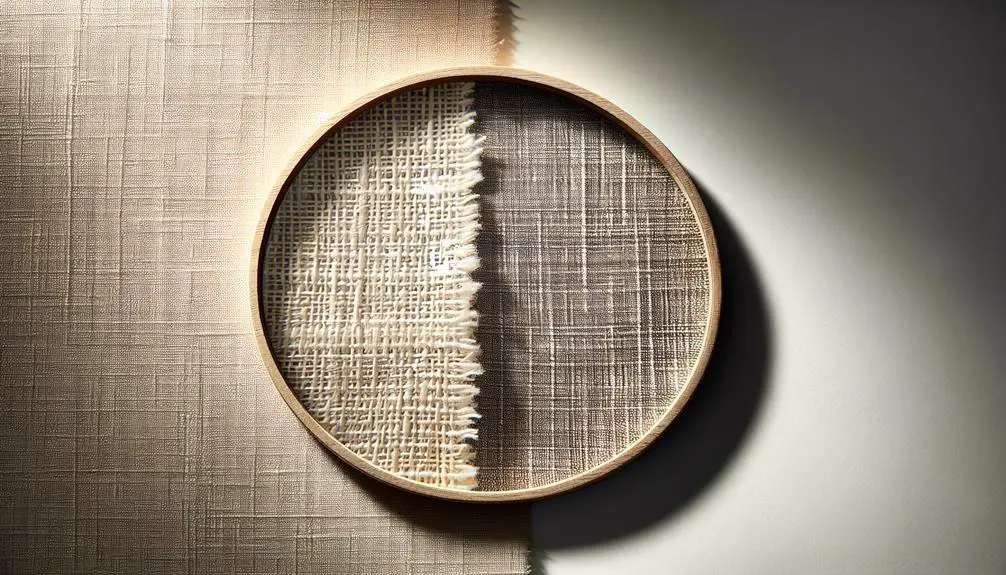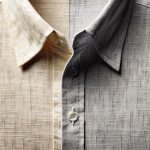I've always been curious about what makes linen high quality, especially with all the options out there. From my experience, it's not just about how it looks fresh off the shelf. You've got to consider the natural creases that give it character and the way it softens over time, hinting at its durability. But there's more to it, like the weight of the fabric and those little slubs that tell you it's the real deal. Now, I'm on the fence about how to test it properly without ruining a good piece. Any thoughts on how to spot top-notch linen without making a costly mistake?
Table of Contents
Key Takeaways
- Look for natural creases, a sign of authentic, high-quality linen due to its low elasticity.
- Assess the fabric's softness, which increases with washes, alongside its initial roughness for durability.
- High-quality linen features slubs, adding to its unique texture and indicating premium craftsmanship.
- Conduct a water test; genuine linen absorbs moisture quickly, showcasing its authenticity and moisture-wicking properties.
- Consider the fabric weight; heavier linen often means better durability and quality, suitable for long-lasting use items.
Identifying Natural Creases
One clear giveaway of high-quality linen is its signature, natural creases that add to its soft, organic appeal. These aren't flaws; they're like a badge of authenticity, showing you've got the real deal. If you're after genuine, high-quality fabric, these creases are your best clue. They're a result of linen's low elasticity, which, unlike fake versions that stay unnervingly smooth, gives linen that relaxed, lived-in look we all love.
Here's the thing: when you run your hand over authentic linen, you'll feel those natural creases. They're not just there for show; they tell a story of quality and craftsmanship. High-quality linen isn't about that perfectly ironed, stiff appearance. It's about embracing those imperfections that actually aren't imperfections at all. They're signs of a fabric that's genuine, of a piece that's going to stand the test of time.
Assessing Softness Over Time
While we've talked about the unique creases that signify high-quality linen, it's also worth noting how these fabrics get even better with age, becoming softer with every wash. Initially, you might find genuine linen a bit rough, but don't let that deter you. This initial texture is a hallmark of durability, yet it promises an increase in comfort as time goes by.
| Wash Number | Softness Level | Notes |
|---|---|---|
| 1st | Moderate | Initially rough, but promising. |
| 5th | Improved | Noticeably softer, more comfortable. |
| 10th | Enhanced | Luxuriously soft, yet remains durable. |
| 20+ | Peak | Ultimate softness, epitome of comfort. |
Testing the softness and feel of linen over time is a reliable method to gauge its quality. As I've come to learn, the transformation is not just about softness; it's about achieving a luxurious feel that only genuine linen can provide. This journey of enhancing comfort without compromising durability is what truly sets high-quality linen apart. So, when you're assessing linen, remember, its real value and quality become apparent not at first touch, but over time.
Evaluating Fabric Sturdiness
Evaluating the sturdiness of linen often reveals its true worth as a durable, long-term investment. When I'm on the hunt for high-quality linen, I pay close attention to how the fabric stands up to the rigors of daily life. It's not just about how it feels on day one; it's about how it performs over time. Linen's reputation for durability isn't just talk. High-quality linen, even with a lower GSM, can withstand a lot of wear and tear, proving its sturdiness.
Authentic linen sheets, for instance, don't just resist wear; they thrive under it. They maintain their quality after years of use, which is a testament to their durability. This is why you'll often find linen in commercial settings, where the fabric's ability to endure frequent use is a must. It's this resilience that sets high-quality linen apart. It doesn't just last; it maintains its character and comfort over the years.
Recognizing Slubs as Quality
When I'm checking out linen, finding slubs in the fabric is a surefire sign I've hit the jackpot on quality. These tiny imperfections aren't flaws but hallmarks of genuine high-quality linen made from natural fibers like flax. Unlike those machine-made polyester blends that mimic the look of linen but feel too perfect, real linen has these slubs. They're a testament to the authentic, organic appeal of the material.
Running my hand over the fabric, feeling for those unique bumps and variations, separates the real deal from the imitations. It's all about touching and seeing the difference. Those slubs tell me that the linen hasn't been overly processed; it retains the natural characteristics that make linen such a sought-after material. The quality of linen isn't just in how it looks but in how it feels against your skin, and those slubs are a big part of that experience.
Conducting the Water Test
After feeling for slubs, another way to spot high-quality linen is to perform the water test. It's a simple yet effective method that really shows the difference between high-quality materials and the rest. You see, authentic linen, made from natural flax fibers, has this incredible ability to absorb water quickly. It's like a magic trick; pour a bit of water on it, and watch how fast it wicks away the moisture.
This isn't just about a cool party trick, though. Authentic linen can soak up to 20% of its weight before it even starts feeling damp. That's a testament to its superior absorbency. And for someone who values linen quality, this feature is a big deal. It means your linen items won't just look good; they'll be practical, keeping you cool and comfortable.
The water test isn't just about proving a point. It's a hands-on way to distinguish real, high-quality linen from those lower-quality alternatives that might look similar but don't hold up when it comes to functionality. So next time you're on the hunt for authentic linen, remember the water test. It's a straightforward step towards ensuring you're investing in quality that lasts.
The Importance of Touch
Feeling the fabric can really tell you a lot about its quality, especially since genuine linen has this cool, smooth touch that's hard to mistake. When I'm on the hunt for good quality linen, the first thing I do is run my fingers over the material. Real linen just feels different; it's got this distinctive texture that synthetic materials can't mimic. It's tightly woven, with fewer pores, which gives it that even and smooth feeling all over.
I've also noticed that real linen has these invisible fibers that you can sort of feel if you pay close attention. It's a subtle indication, but it screams premium quality to me. Plus, the softer feel with less skin snag? That's a telltale sign of high-quality linen in my book. It means the weave is even and smooth throughout the fabric.
Another trick I've learned is checking how fast it absorbs water. Real linen is like a super sponge because of its high moisture-wicking properties. If it sucks up water quickly, you're probably holding the real deal. It's these little tests that can help you spot the difference between genuine linen and the synthetic wannabes.
Analyzing Color Consistency
Moving on to color consistency, it's crucial to note that high-quality linen will always show an even and vibrant tone throughout, signaling a careful dyeing process. When I'm picking out quality linens, I always keep an eye out for that perfect hue that tells me the fabric didn't just come off the assembly line without thought. It's not just about the shade itself, but how that color presents across every inch of the material.
- Rich and vibrant colors: They're your first clue to high-quality linen. These hues don't fade into the background; they stand out because they're the result of meticulous dyeing.
- Even color consistency: This is non-negotiable. Any signs of uneven color distribution immediately raise a red flag for me, indicating possible shortcuts in the dyeing process.
- No frosting or yellowing: These imperfections scream subpar dyeing techniques. Quality linen should look as good on day one as it does after several washes.
- Inspect for consistent coloration: Especially important to avoid linen that's been subjected to harsh whitening agents, resulting in yellowing.
It's all about knowing what signals to look for and understanding that even the smallest detail, like color consistency, can speak volumes about the quality of linen.
Understanding Fabric Weight
Diving into the world of linen, it's essential to understand that the weight of the fabric plays a crucial role in determining its quality. When I'm on the hunt for high-quality linen fabric, I always check the fabric weight first. It's a straightforward indicator that doesn't lie. Heavier textiles are generally a sign of higher quality. They've this substantial feel that screams durability and longevity.
Now, don't get me wrong, lightweight linens have their place, but when you're after something that's going to stand the test of time, heavyweight linen is where it's at. It's more resistant to wear and tear, making it a no-brainer for items you'll use daily. Think about it; a heavyweight linen tablecloth or bed sheets are going to endure much more than their lighter counterparts.
Frequently Asked Questions
How Can You Tell Good Quality Linen?
To spot good quality linen, I look for slubs, quick-drying properties, natural creases, and a thicker weave. It's also about where it's from—Ireland, Italy, and Belgium are my go-to for the best stuff.
How Can You Tell if Something Is 100% Linen?
To check if something's 100% linen, I firstly peek at the materials tag. If it's pure, it'll say so. I also look for little nubs in the fabric and expect a slightly rough texture.
What to Look for When Buying Linen?
When I'm buying linen, I always check for slubs, smooth edges, and rich colors. It's gotta feel thick and absorb water well. I look for tight weaves, even texture, and neat stitching too.
What Is the Highest Quality Linen Fabric?
I've learned the highest quality linen comes from European flax, especially from Ireland, Italy, and Belgium. It's got a tight weave, natural texture, and softens beautifully over time. Always check for even color and tight stitching.
- What Is a Nonwoven Textile? a Broad Definition - July 9, 2025
- What Is a Nonwoven Textile? a Broad Definition - July 9, 2025
- What Is a Nonwoven Textile? a Broad Definition - July 9, 2025







